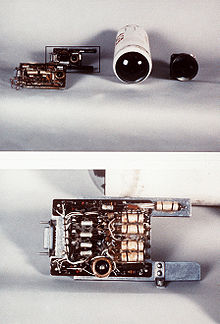Wympel R-3
| Wympel K-13 (R-3S and R-3R or AA-2A / D "Atoll") | |
|---|---|
| General Information | |
| Type | tactical air-to-air guided missile |
| Manufacturer | GMKB Wympel ( Design Office (OKB) Bisnowat ) |
| development | 1958 |
| Commissioning | 1960 |
| Technical specifications | |
| length | 2.84 m |
| diameter | 127 mm |
| Combat weight | 75 kg |
| span | 450 (K-13A) / 530 mm (K-13R) |
| drive | Solid rocket |
| speed | Do 2.5 |
| Range | 6.5 km |
| Furnishing | |
| Target location | Infrared (K-13A), semi-active radar (K-13R) |
| Warhead | 11 kg |
| Weapon platforms | Fighter planes |
| Lists on the subject | |
R-3 is a Soviet air-to-air missile with the NATO designation AA-2 "Atoll" . The guided missile, also known as the Wympel K-13 , was created as a copy of the AIM-9 Sidewinder .
history
How the Soviet Union got hold of a Sidewinder missile can only be guessed at. On September 24, 1958, a Taiwanese North American F-86 fired a Sidewinder at a Chinese Mikoyan-Gurevich MiG-17 . The missile did not explode but got stuck in the MiG-17. Another says that in 1958 a US Navy fighter plane was shot down over mainland China with Sidewinder on board. After both variants, the Chinese delivered the remains of an AIM-9 to the Soviet Union, which was handed over to the OKB-4 for evaluation and replication. By 1967 at the latest, the Soviet troops had a Sidewinder at their disposal, which the Krefeld architect Manfred Ramminger, with the help of his driver and Starfighter pilot Wolf-Diethard Knoppe, had stolen from the West German air base in Neuburg on October 22, 1967. The rocket was later - dismantled into unsuspicious parts - transported to Moscow via Düsseldorf Airport. The trio were arrested a year later.
technology
The infrared homing device and the control device of the Sidewinder have had a strong influence on the development of Soviet guided missiles.
variants
First a version was developed that also worked with an infrared seeker head and was supplied to the air forces from 1960 . In 1961, based on this version, known as K-13A , the development of a variant with a semi-active radar seeker head began. The new guided missile K-13R - designated by NATO as AA-2-2 "Advanced Atoll" - was delivered to the armed forces from 1966. The R-3 was produced under license in China under the name PL-2 and based on this, the Chinese PL-3 and PL-5 guided missiles were developed.
- K-13A: Basic variant for testing
- K-13S (AA-2A "Atoll"): R-3S first production version
- PL-2: Chinese license version of the K-13S
- K-13M (AA-2C "Atoll"): R-13M improved production version
- K-13M1 (AA-2D "Atoll"): R-13M1 improved production version
- K-13R (AA-2-2 "Advanced Atoll"): R-3R variant with semi-active radar
Carrier aircraft
- Aero L-39 "Albatros"
- Mikoyan-Gurevich MiG-19PT ("Farmer")
- Shenyang J-6B
- Sukhoi Su-17 ("Fitter")
- Sukhoi Su-25 ("Frogfoot")
- Mikojan-Gurewitsch MiG-21 ("Fishbed") from version MiG-21F-13
- Mikoyan-Gurewitsch MiG-23 ("Flogger")
Web links
Individual evidence
- ↑ Thomas Newbick: Postwar Air Weapons 1945-present. Amber Books Ltd, 2011.


